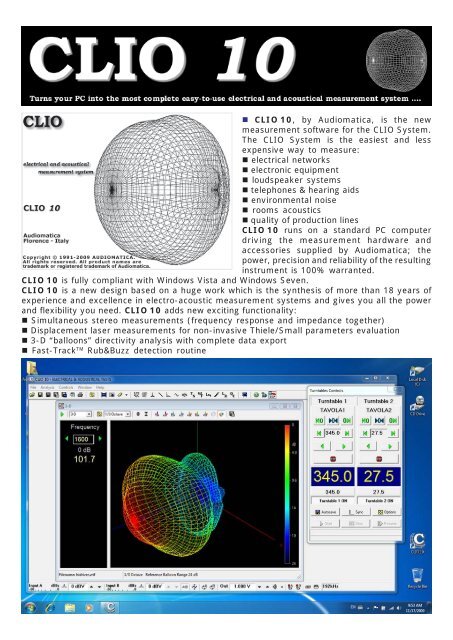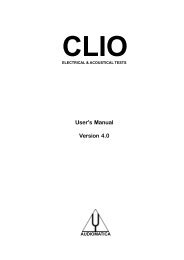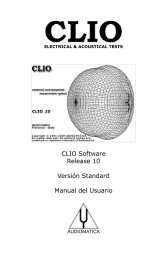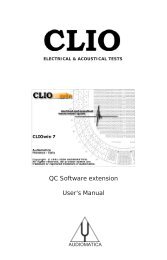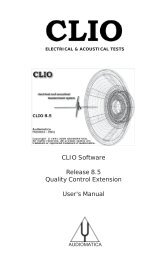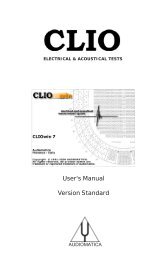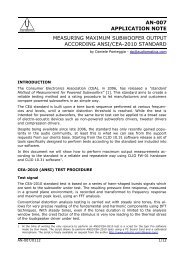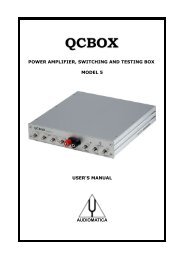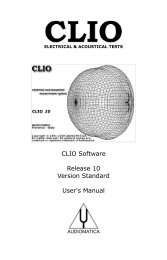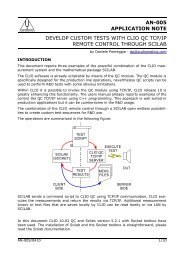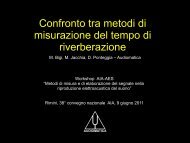Depliant Cliowin - Audiomatica
Depliant Cliowin - Audiomatica
Depliant Cliowin - Audiomatica
Create successful ePaper yourself
Turn your PDF publications into a flip-book with our unique Google optimized e-Paper software.
• CLIO 10, by <strong>Audiomatica</strong>, is the new<br />
measurement software for the CLIO System.<br />
The CLIO System is the easiest and less<br />
expensive way to measure:<br />
• electrical networks<br />
• electronic equipment<br />
• loudspeaker systems<br />
• telephones & hearing aids<br />
• environmental noise<br />
• rooms acoustics<br />
• quality of production lines<br />
CLIO 10 runs on a standard PC computer<br />
driving the measurement hardware and<br />
accessories supplied by <strong>Audiomatica</strong>; the<br />
power, precision and reliability of the resulting<br />
instrument is 100% warranted.<br />
CLIO 10 is fully compliant with Windows Vista and Windows Seven.<br />
CLIO 10 is a new design based on a huge work which is the synthesis of more than 18 years of<br />
experience and excellence in electro-acoustic measurement systems and gives you all the power<br />
and flexibility you need. CLIO 10 adds new exciting functionality:<br />
• Simultaneous stereo measurements (frequency response and impedance together)<br />
• Displacement laser measurements for non-invasive Thiele/Small parameters evaluation<br />
• 3-D “balloons” directivity analysis with complete data export<br />
• Fast-Track TM Rub&Buzz detection routine
• CLIO 10 MAIN SOFTWARE RELEASES AND VERSIONS<br />
CLIO 10 controls and manages the <strong>Audiomatica</strong> FW-01 Firewire Audio Interface (24 bit @ 192kHz).<br />
CLIO 10 STANDARD: Laboratory grade software with most of the features present.<br />
CLIO 10 QC: Adds a Quality Control Processor for state-of-the-art testing and controlling a<br />
production line; also adds some particular applications like 3D measurement analysis.<br />
• CLIO 10 MEASUREMENT TECHNIQUES<br />
Compared to other measurement systems, CLIO 10 concentrates the power of many different<br />
instruments into a single one.<br />
Three different measurement techniques are available for system identification and characterization:<br />
• MLS & LogChirp analysis using either pseudo-random noise or logarithmic chirps as stimuli<br />
• Sinusoidal Sweeps using sinusoidal signals<br />
• FFT, RTA and ‘Live’ Transfer Function letting you the choice of any stimulus, even live music.<br />
While other instruments offer one single possible measurement choice, CLIO 10 gives you three<br />
alternatives permitting to view the physical phenomenon like frequency response, impedance or<br />
other parameters, from three different points of view. The final result will be then validated by the<br />
consistency of these measurements: as any expert technician knows, this is the correct approach<br />
that should always be adopted.<br />
The following specialized control panels are dedicated to other specific measurements:<br />
• Sound Level Meter a IEC61672 integrating sound level meter with Leq and frequency analysis<br />
• Linearity and Distortion measures the non linear behavior of an electronic equipment<br />
• Interactive L-C-R Bridge permits passive components measurement on the fly<br />
• Wow&Flutter Meter with time and frequency analysis<br />
• Frequency Counter<br />
Beyond measured results you get sophisticated post-processing tools for:<br />
• Thiele&Small Parameters for loudspeaker characterization<br />
• ISO 3382 Acoustical Parameters & STI for rooms and auditoria characterization<br />
• Waterfall plots to evaluate sound decay as 3D or Color graphs<br />
• Directivity analysis for loudspeaker characterization as Color maps, Circular or waterfall-like plots<br />
• 3-D Balloons analysis for complete 3D loudspeaker directivity characterization<br />
• Wavelet analysis for joint time-frequency loudspeaker characterization<br />
• Loudness Rating Calculator for assessing RLR, SLR and STMR (only in QC version)<br />
Using all the aforementioned measuring and post-processing techniques it is possible to tailor<br />
powerful Quality Control scripts that will manage and identify any production line of electronic or<br />
electro-acoustic devices.<br />
• MLS & LOG CHIRP ANALYSIS<br />
CLIO 10 implements linear systems measurement with the well established MLS analysis technique<br />
now enriched by the possibility of using Logarithmic<br />
Chirps. The result is the system’s impulse<br />
response measurement, by means of<br />
sophisticated algorithms; this lets you perform<br />
accurate anechoic analysis of loudspeakers and<br />
room acoustics evaluation. The measurement is<br />
highly accurate and extremely fast to execute;<br />
the data recorded by the computer, can be<br />
instantly analyzed or stored for later processing.<br />
What MLS & LogChirp analysis gives you:<br />
• MLS and Chirp size up to 512k.<br />
Impulse response<br />
• Frequency response<br />
• Phase response, minimum and excess.<br />
• Group Delay<br />
• Impedance measurement<br />
• Step response<br />
• Energy-Time curve (ETC)<br />
• Schroeder reverberant decay<br />
• Selectable analysis window<br />
• Manual or continuous programmable time<br />
average<br />
• Loop function with continuous measurement<br />
• Mathematical operations on data in memory<br />
Frequency response
• Automatic merge between near and far field<br />
• Selectable smoothing (1/2 to 1/12 of octave)<br />
• SINUSOIDAL ANALYSIS<br />
CLIO 10 executes sinusoidal analysis with a<br />
digital filtering of input signal to achieve the highest<br />
noise-immunity; in this way you add the power of<br />
the PC to the most traditional frequency analysis.<br />
The sinusoidal technique is oriented to:<br />
• Stereo sweep for simultaneous frequency and<br />
impedance response<br />
• Phase response<br />
• A/B channels difference response<br />
• Continuous and stepped sweeps<br />
• Sweep amplitude equalization vs. frequency<br />
• Frequency resolution from 1/3 to 1/48 oct.<br />
• 2nd to 10th harmonic and THD plot vs. frequency<br />
• Fast-Track TM Rub&Buzz plot vs. frequency<br />
• Gating system with auto-delay for quasi-anechoic<br />
measurements<br />
• FFT, RTA & ‘LIVE’ TRANSFER FUNCTION<br />
These measurements are implemented with an<br />
interactive control panel that permits the simultaneous<br />
display of time and frequency domains.<br />
Three operating modes:<br />
• Narrowband FFT<br />
• Octave bands RTA<br />
• ‘LIVE’ transfer function<br />
The main features are:<br />
• Two channels measurement and display<br />
• Internal trigger with programmable delay<br />
• FFT from 256 points up to 128k points<br />
• Linear or exponential averaging<br />
• Max hold and min hold functions<br />
• Linear or logarithmic frequency axis<br />
• 1/3 octave or 1/6 octave RTA display<br />
• Equal Loudness Contours display<br />
• Frequency smoothing<br />
It is possible to easily execute bursted distortion<br />
measurements delivering, for a definable short<br />
period of time, very high power to the load.<br />
• MULTI-METER<br />
This multi-meter control panel is a real-time,<br />
interactive, measuring instrument giving the following<br />
functionality:<br />
• SPL Meter (dBSPL, dBPa, dBA, dBC)<br />
• Millivoltmeter (V, dBV, dBu, dBr)<br />
• Displacement (m, dBmeter)<br />
• Velocity (m/s, dBm/s)<br />
• Acceleration (g, m/s 2 , dBm/s 2 )<br />
• Frequency Counter (Hz)<br />
• Distortion meter: THD and IMD (%, dB)<br />
• L-C-R Bridge (H, uF, Ohm)<br />
• Crest Factor<br />
• Fast and Slow integration<br />
• SIGNAL GENERATOR<br />
The programmable signal generator is capable of<br />
the following functions or signals generation:<br />
• Sinusoids with burst and FFT bin round<br />
• Two sinusoids<br />
Sinusoidal response + harmonics<br />
Narrowband FFT<br />
Octave bands RTA<br />
‘LIVE’ transfer function<br />
Multimeter and signal generator
• Multitones & All Tones<br />
• Linear or Logarithmic Chirps<br />
• MLS (Maximum Length Sequences)<br />
• Pink and White noise<br />
• Wave files (.wav) playback and save<br />
• IMPEDANCE MEASUREMENTS AND<br />
THIELE&SMALL PARAMETERS<br />
The impedance measurements can be done with<br />
a direct connection to the analyzing hardware or<br />
with an external amplifier and a sensing resistor<br />
both in constant current or constant voltage<br />
configurations. Using an <strong>Audiomatica</strong> QCBox<br />
Amplifier, its current sensing output is used to<br />
permit simultaneous frequency response and<br />
impedance measurement. The evaluation of<br />
speaker parameters may use a single-pass, noninvasive,<br />
laser displacement measurement or the<br />
classical added-mass or known-volume methods<br />
with least square error routines.<br />
• WATERFALL, DIRECTIVITY & 3-D<br />
The Waterfall, Directivity and 3-D post processing<br />
routines give CLIO 10 the possibility of making<br />
3D or Color plots by adding a third dimension (time<br />
or degrees) to classical amplitude-frequency<br />
graphs. Waterfalls are used to characterize the<br />
anechoic sound decay of a loudspeaker or the<br />
Impedance and T&S parameters<br />
Waterfall<br />
Color Waterfall<br />
sound decay in a room.<br />
The Waterfall post processing permits the following<br />
3-D or Color types of analysis:<br />
• Cumulative spectral decay (CSD)<br />
• Energy Time Frequency (ETF)<br />
Directivity analysis characterizes the radiation of<br />
a loudspeaker versus vertical or horizontal angle.<br />
The Directivity post processing permits the following<br />
analysis:<br />
• 3-D directivity (waterfall like)<br />
• Color map directivity<br />
• Classical polar plots<br />
To fully measure and characterize the radiation of<br />
a loudspeaker in space there are the following (in<br />
QC software version only):<br />
• 3-D turntables control<br />
• 3-D measurement manager<br />
• 3-D “Balloons” analysis<br />
• Data export in text formats as EASE (.xhn),<br />
CLF (.tab) or impulse responses.<br />
Balloon data is thus available to import in simulation<br />
software packages.<br />
Directivity color map<br />
Circular polar plots<br />
3-D Balloon, turntables control and measurement manager
• WAVELET ANALYSIS<br />
The Wavelet Analysis tool allows to post-process<br />
impulse responses and to create color plots of the<br />
energy of the signal versus time and frequency.<br />
The tool is similar to the Energy Time Frequency<br />
analysis but, since it is based on wavelet transform<br />
instead of Fourier Transform, does not suffer<br />
from a fixed time-frequency resolution.<br />
• Leq ANALYSIS<br />
With the Leq Analysis control panel it is possible to<br />
execute real-time capture and level measurement<br />
of any kind of signal present at CLIO’s input.<br />
The behaviour of the instrument closely resemble<br />
that of a graphical level recorder plus direct-todisk<br />
data capture. When analyzing an acoustical<br />
event this control panel gives you complete<br />
information about the equivalent continuous sound<br />
level (Leq) and related quantities according to IEC<br />
61672 standard; if used together the FFT frequency<br />
analysis you get a complete integrating<br />
sound level meter.<br />
• ACOUSTICAL PARAMETERS & STI<br />
With the Acoustical Parameters control panel it is<br />
possible to evaluate the acoustical behaviour of a<br />
room and carry out sophisticated post processing<br />
of a measured impulse response to calculate the<br />
acoustical parameters as defined by the ISO<br />
3382 standard. The STI, Speech Transmission<br />
Index, is also calculated. All these parameters are<br />
of common use to characterize auditoria, concert<br />
halls and are applicable to any room intended for<br />
speech or music reproduction.<br />
• LINEARITY AND DISTORTION<br />
Linearity and Distortion analysis is a complete tool<br />
to inspect the non linear behavior of any electronic<br />
equipment as power amplifiers or preamplifiers.<br />
• Up to 1250W/8Ohm (higher with external<br />
attenuator)<br />
• THD vs. input or output<br />
• SMPTE, DIN, CCIFF Intermodulation<br />
• DUT’s gain and deviation from linearity<br />
• WOW & FLUTTER ANALYSIS<br />
CLIO 10 executes Wow & Flutter analysis<br />
measuring the frequency modulation that follows<br />
instantaneous speed variations due to mechanical<br />
imperfections in analog recording or playback<br />
devices.<br />
• IEC and NAB standards<br />
• Time and frequency display<br />
• CLIO 10 USER INTERFACE<br />
The various control panels give you the impression<br />
of facing a real instrument. The software displays<br />
multiple curves giving you powerful editing<br />
capabilities together import and export facilities as<br />
a link to simulation programs. Featuring:<br />
• Measurement session management<br />
• ASCII data output<br />
• EMF, Bitmap, PNG, GIF, JPEG graphics export<br />
Wavelet<br />
Leq analysis<br />
ISO 3382 Acoustical Parameters<br />
Distortion vs. output power<br />
Wow & Flutter
• QUALITY CONTROL<br />
The Quality Control software extension for CLIO 10 is a powerful suite for executing state of the<br />
art production line testing. CLIO 10 QC is able to test the production of loudspeakers, drivers,<br />
microphones, amplifiers and any other electroacoustic device. CLIO 10 QC can interact with<br />
external hardware or production line controllers in addition to PC peripherals to implement a fully<br />
automatic line. CLIO 10 QC is also able to behave as a TCP/IP measurement server to let you<br />
write and implement your custom written code. CLIO 10 QC takes full advantage of all the<br />
measurement techniques found in the CLIO standard software adding a versatile script processor<br />
capable of handling a virtually unlimited sequence of tests to accomplish even the most complex<br />
tasks; on the other hand a single<br />
ultra-fast sinusoidal test may ensure<br />
you production cycle times of less<br />
than 1 second.<br />
Some of the quality control checks<br />
possible within one single test:<br />
• Frequency response and impedance<br />
response (mono or stereo tests)<br />
• Average (or single frequency) level<br />
• Sensitivity (average or up to eight<br />
frequencies)<br />
• Polarity<br />
• Total harmonic distortion response<br />
• Single harmonic response (from 2nd<br />
to 10th)<br />
• Fast-Track TM Rub&Buzz response<br />
• T&S parameters (Fs, Qt, Qe, Qm,<br />
Cms, Mms, Mmd, Vas, Bl, dBSPL, ZMin)<br />
• Loudness Rating (RLR, SLR, STMR)<br />
• POWERFUL HARDWARE CONTROL<br />
The key feature of the CLIO System running CLIO 10 is the precision, laboratory grade, hardware<br />
control that gives you complete, instant access to all the measurement parameters and let you<br />
easily interact via software to adapt your measurement interface to any environmental need; using<br />
CLIO you get results that are 100% warranted by the hardware interface built by <strong>Audiomatica</strong>.<br />
• Stereo input and output control<br />
• Peak Meter to monitor input signal<br />
• 0.1dB output level control<br />
• Output DC voltage control<br />
• CLIO 10 integrates the software control for the new<br />
Model 5 Amplifier, Switching and Testing box:<br />
• USB controlled<br />
• 50W (8Ohm) output stage w/DC control<br />
• Output stage current limit control<br />
• 4 input w/phantom supply (programmable 0÷24V)<br />
• 2 DC voltage measuring input<br />
• I-Sense output with DC current measuring<br />
• General Purpose I/O bits<br />
• PC REQUIREMENTS<br />
• CLIO 10: P4 or Dual Core 2Ghz; XP, Vista or 7.<br />
AUDIOMATICA<br />
VIA MANFREDI 12- 50136 FIRENZE-ITALY<br />
TEL:+39-0556599036-FAX:+39-0556503772<br />
E-MAIL: info@audiomatica.com<br />
WEB:www.audiomatica.com,www.cliosystem.com<br />
ELECTRICAL & ACOUSTICAL TESTS


